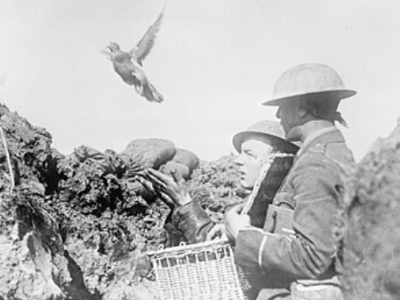William of Orange xxx
19 September 1944
Eighty years ago on Thursday, 19 September 1944, was a day to remember for William of Orange. William of Orange the pigeon, that is. Let’s rewind a little first…
I used to think that a pigeon’s only role was to poop all over my car, for me to then clean off each weekend. But it turns out they can be quite heroic and valuable.
The National Pigeon Service, formed in 1939, thought so too. Its role was to support military communications through the impending World War II by way of carrier pigeons... the original airmail service.
200,000 pigeons served, first under the wing of the RAF but subsequently stationed across all the military branches.
Pigeons have extraordinary homing powers. They combine visual cues with magnetoreception, using the Earth’s magnetic field to guide them. Further, they can use the sun as a compass and star patterns at night to navigate. For this reason, they make excellent message carriers, particularly in times of war.
Pigeons in war zones would sit tight in their cages day after day, munching on a carefully prepared mix of seeds selected for peak health and fitness.
Troops release a carrier pigeon in the field,1940. See page for author, via Wikimedia Commons
Then, without a moment’s notice, they were released into the void with vital messages bound to their ankles. The pigeons' homing senses would guide them back to their lofts and pigeon houses in England, sometimes hundreds of miles away. The messages were then retrieved and circulated.
To help the success of these mercy flights, birds of prey were culled along the English coastline to stop the pigeons from being eaten on their way home.
Despite the cull, very few pigeons would complete their journey. Enemy soldiers realised the importance of these pigeons and fired shotguns to bring them down.
If the birds weren’t peppered with shot early in their journey, they then had to survive general artillery fire, trained intercept predators such as Peregrine falcons and harsh weather conditions, particularly through the winter months.
I first encountered these extraordinary war pigeon exploits during a recent visit to Bletchley Park, home of the German Enigma machine code breakers. Bletchley Park had its own classified MI6 pigeon loft, the site of many successful message retrievals and pigeon home-comings during the war.
Sir William Proctor Smith bred the hapless William of Orange in 1942 in Knutsford, Cheshire. During training with MI14, he was earmarked for his speed - the pigeon, that is, not William Proctor Smith.
William of Orange – the pigeon, 1944: See page for author, Public domain, via Wikimedia Commons
William of Orange was selected to join the 2nd Parachute Battalion in September 1944, posted close to the Rhine Bridge near Arnhem.
Although he didn't know it, William was now part of Operation Market Garden, a major offensive during the war to breach lines in German-occupied Netherlands and gain quick access into Germany through the back door.
On 19 September, William’s battalion hit double trouble. The Germans had surrounded the 2nd at the same time that its radio equipment had failed. An alternative method of communication was needed to relay a message home requesting help.
Primed with a few slurps of his favourite beer, William of Orange was released by the British soldiers, carrying the critical news of their predicament around his leg.
Flying in the face of danger, William dodged enemy shotgun fire to reach the English Channel. From there, he contended with the unbridled force of the Channel winds but flapped on regardless towards his humble loft in Knutsford. Four hours and 250 miles later, he arrived.
The message was passed to the British High Command, who were unaware of the dire situation in Arnhem. A full-scale withdrawal was ordered, saving many lives. Unfortunately, the message arrived too late to help William's battalion. Of the 750 men in the battalion, only 100 survived.
Following in the illustrious wing flaps of White Vision, Winkie and Tyke, William of Orange received the animal equivalent of the Victoria Cross. The Dickin Medal was awarded for his gallantry, devotion to duty and presumably for not ruffling too many feathers along the way.


